Abstract
While there are many instances of single neurons that can drive rhythmic stimulus-elicited motor programs, such neurons have seldom been found to be necessary for motor program function. In the isolated central nervous system of the marine mollusc Tritonia diomedea, brief stimulation (1 sec) of a peripheral nerve activates an interneuronal central pattern generator that produces the long-lasting (approximately 30-60 sec) motor program underlying the animal's rhythmic escape swim. Here, we identify a single interneuron, DRI (for dorsal ramp interneuron), that (i) conveys the sensory information from this stimulus to the swim central pattern generator, (ii) elicits the swim motor program when driven with intracellular stimulation, and (iii) blocks the depolarizing "ramp" input to the central pattern generator, and consequently the motor program itself, when hyperpolarized during the nerve stimulus. Because most of the sensory information appears to be funneled through this one neuron as it enters the pattern generator, DRI presents a striking example of single neuron control over a complex motor circuit.
Full text
PDF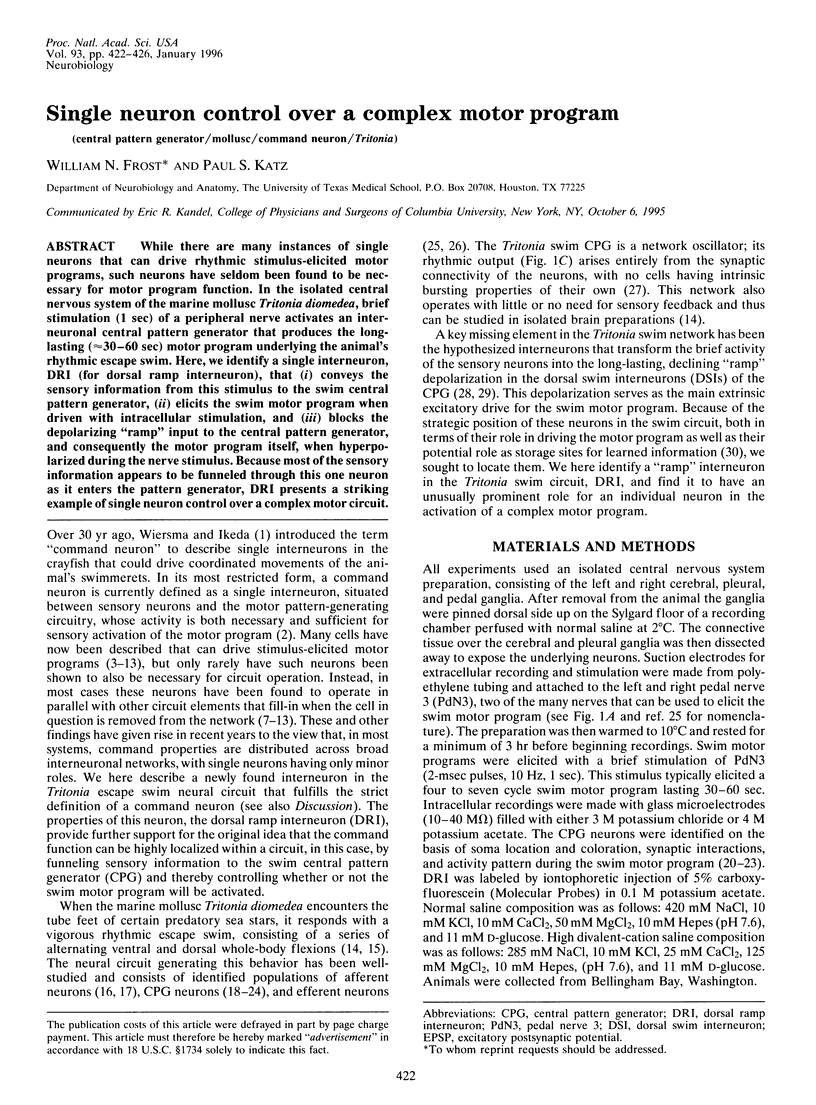
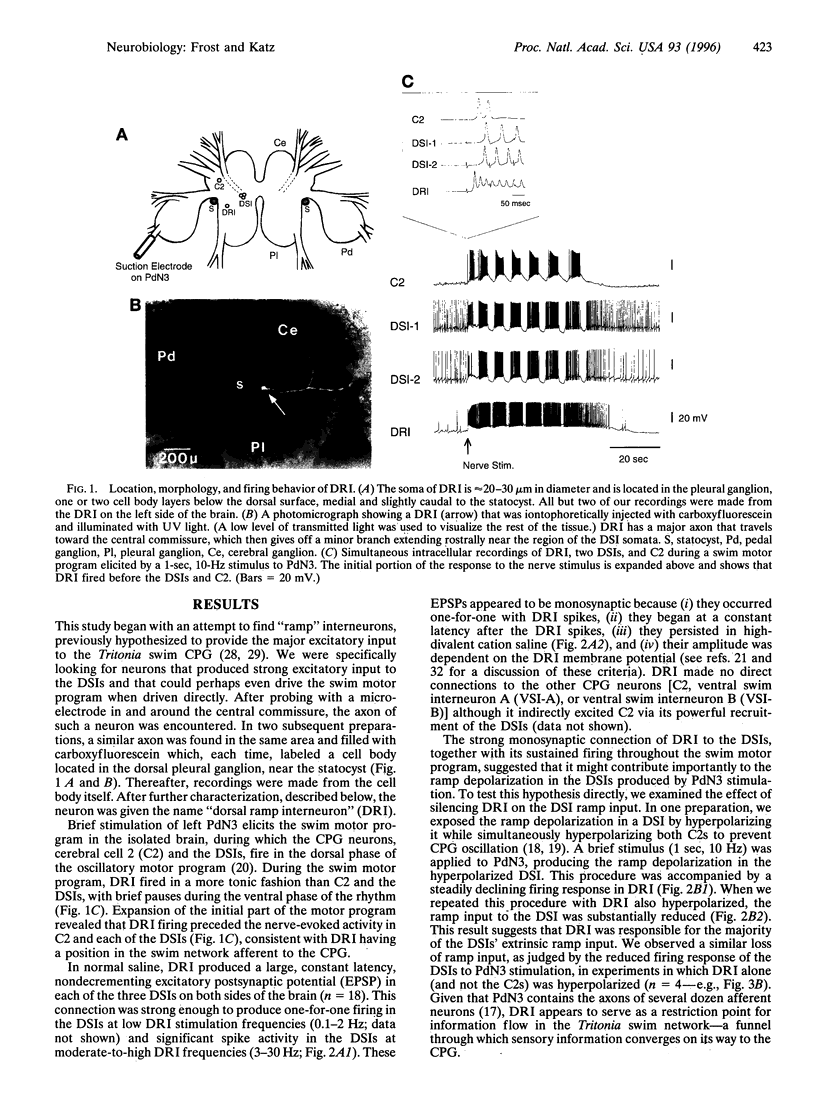
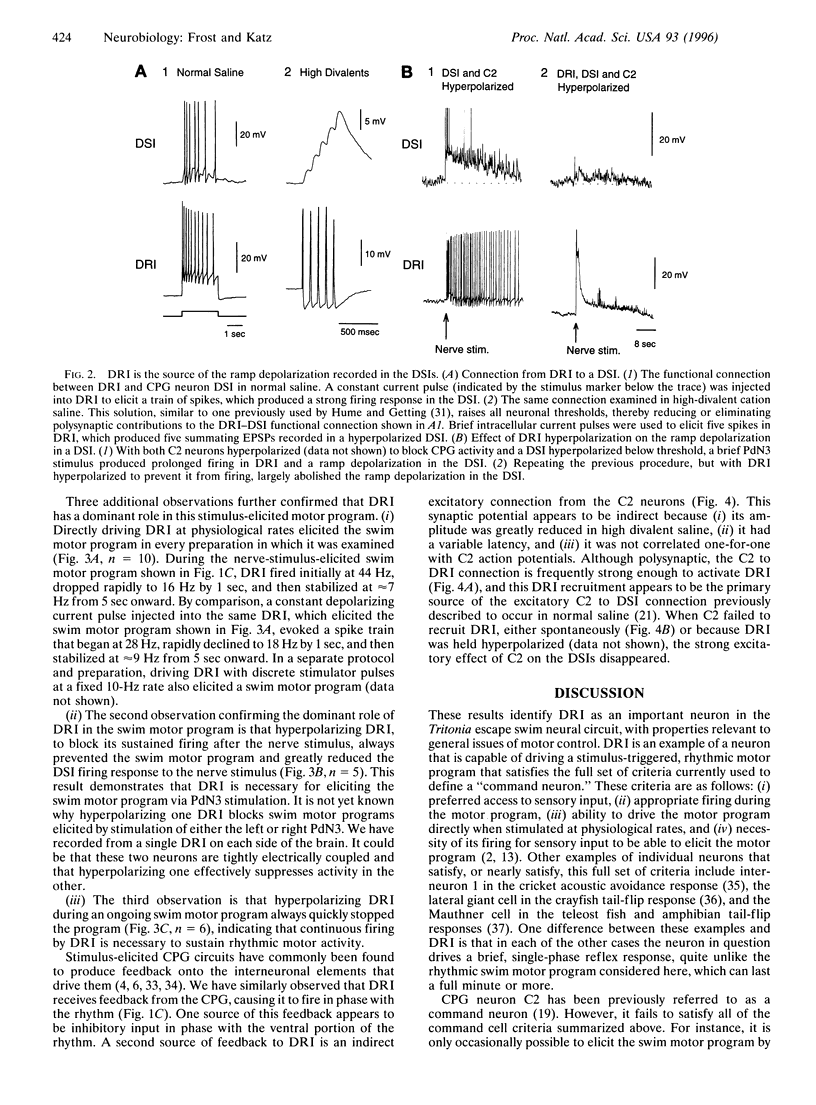
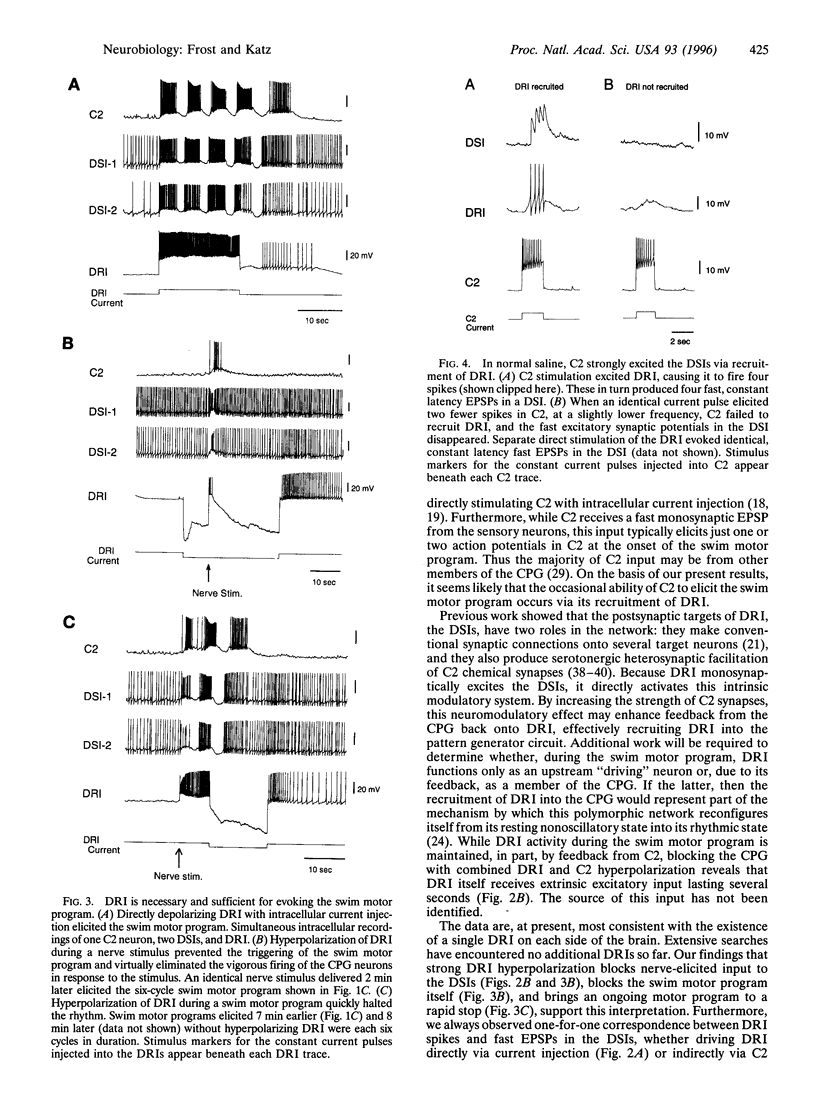
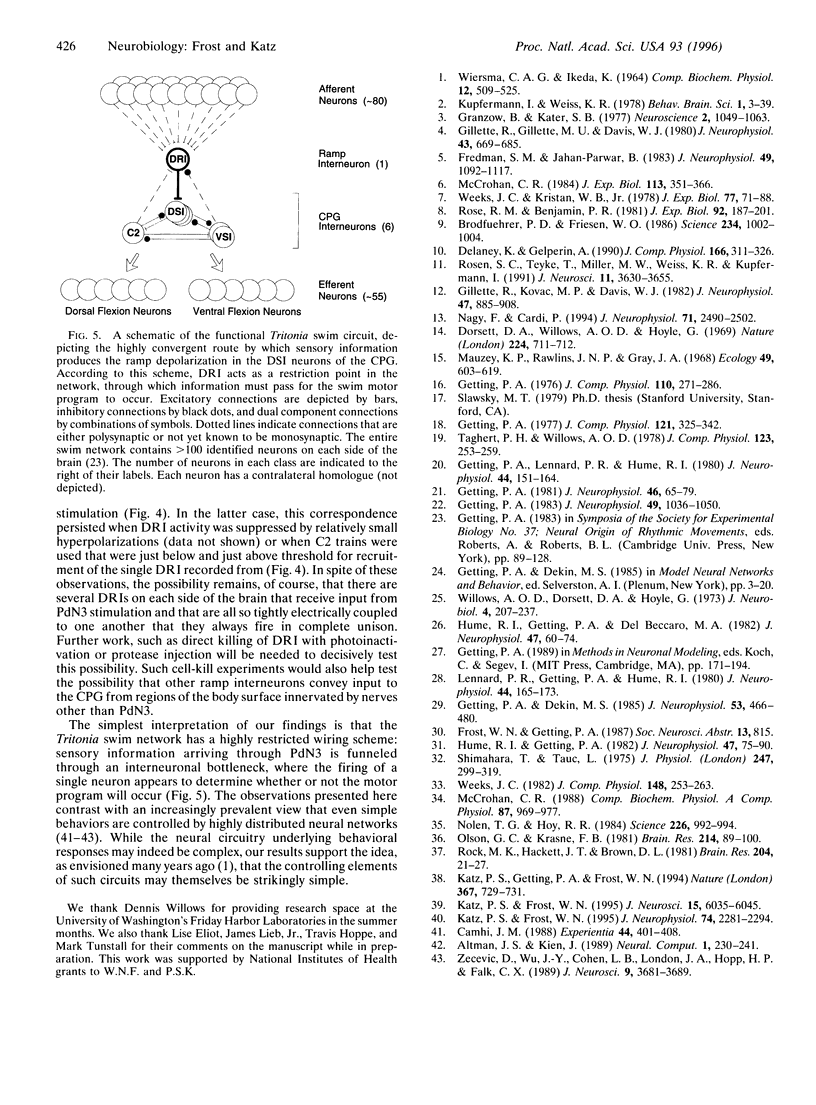
Images in this article
Selected References
These references are in PubMed. This may not be the complete list of references from this article.
- Brodfuehrer P. D., Friesen W. O. From stimulation to undulation: a neuronal pathway for the control of swimming in the leech. Science. 1986 Nov 21;234(4779):1002–1004. doi: 10.1126/science.234.4779.1002. [DOI] [PubMed] [Google Scholar]
- Camhi J. M. Escape behavior in the cockroach: distributed neural processing. Experientia. 1988 May 15;44(5):401–408. doi: 10.1007/BF01940534. [DOI] [PubMed] [Google Scholar]
- Fredman S. M., Jahan-Parwar B. Command neurons for locomotion in Aplysia. J Neurophysiol. 1983 May;49(5):1092–1117. doi: 10.1152/jn.1983.49.5.1092. [DOI] [PubMed] [Google Scholar]
- Getting P. A., Dekin M. S. Mechanisms of pattern generation underlying swimming in Tritonia. IV. Gating of central pattern generator. J Neurophysiol. 1985 Feb;53(2):466–480. doi: 10.1152/jn.1985.53.2.466. [DOI] [PubMed] [Google Scholar]
- Getting P. A., Lennard P. R., Hume R. I. Central pattern generator mediating swimming in Tritonia. I. Identification and synaptic interactions. J Neurophysiol. 1980 Jul;44(1):151–164. doi: 10.1152/jn.1980.44.1.151. [DOI] [PubMed] [Google Scholar]
- Getting P. A. Mechanisms of pattern generation underlying swimming in Tritonia. I. Neuronal network formed by monosynaptic connections. J Neurophysiol. 1981 Jul;46(1):65–79. doi: 10.1152/jn.1981.46.1.65. [DOI] [PubMed] [Google Scholar]
- Getting P. A. Mechanisms of pattern generation underlying swimming in Tritonia. III. Intrinsic and synaptic mechanisms for delayed excitation. J Neurophysiol. 1983 Apr;49(4):1036–1050. doi: 10.1152/jn.1983.49.4.1036. [DOI] [PubMed] [Google Scholar]
- Gillette R., Gillette M. U., Davis W. J. Action-potential broadening and endogenously sustained bursting are substrates of command ability in a feeding neuron of Pleurobranchaea. J Neurophysiol. 1980 Mar;43(3):669–685. doi: 10.1152/jn.1980.43.3.669. [DOI] [PubMed] [Google Scholar]
- Gillette R., Kovac M. P., Davis W. J. Control of feeding motor output by paracerebral neurons in brain of Pleurobranchaea californica. J Neurophysiol. 1982 May;47(5):885–908. doi: 10.1152/jn.1982.47.5.885. [DOI] [PubMed] [Google Scholar]
- Hume R. I., Getting P. A., Del Beccaro M. A. Motor organization of Tritonia swimming. I. Quantitative analysis of swim behavior and flexion neuron firing patterns. J Neurophysiol. 1982 Jan;47(1):60–74. doi: 10.1152/jn.1982.47.1.60. [DOI] [PubMed] [Google Scholar]
- Hume R. I., Getting P. A. Motor organization of Tritonia swimming. II. Synaptic drive to flexion neurons from premotor interneurons. J Neurophysiol. 1982 Jan;47(1):75–90. doi: 10.1152/jn.1982.47.1.75. [DOI] [PubMed] [Google Scholar]
- Katz P. S., Frost W. N. Intrinsic neuromodulation in the Tritonia swim CPG: serotonin mediates both neuromodulation and neurotransmission by the dorsal swim interneurons. J Neurophysiol. 1995 Dec;74(6):2281–2294. doi: 10.1152/jn.1995.74.6.2281. [DOI] [PubMed] [Google Scholar]
- Katz P. S., Frost W. N. Intrinsic neuromodulation in the Tritonia swim CPG: the serotonergic dorsal swim interneurons act presynaptically to enhance transmitter release from interneuron C2. J Neurosci. 1995 Sep;15(9):6035–6045. doi: 10.1523/JNEUROSCI.15-09-06035.1995. [DOI] [PMC free article] [PubMed] [Google Scholar]
- Katz P. S., Getting P. A., Frost W. N. Dynamic neuromodulation of synaptic strength intrinsic to a central pattern generator circuit. Nature. 1994 Feb 24;367(6465):729–731. doi: 10.1038/367729a0. [DOI] [PubMed] [Google Scholar]
- Lennard P. R., Getting P. A., Hume R. I. Central pattern generator mediating swimming in Tritonia. II. Initiation, maintenance, and termination. J Neurophysiol. 1980 Jul;44(1):165–173. doi: 10.1152/jn.1980.44.1.165. [DOI] [PubMed] [Google Scholar]
- Nagy F., Cardi P. A rhythmic modulatory gating system in the stomatogastric nervous system of Homarus gammarus. II. Modulatory control of the pyloric CPG. J Neurophysiol. 1994 Jun;71(6):2490–2502. doi: 10.1152/jn.1994.71.6.2490. [DOI] [PubMed] [Google Scholar]
- Nolen T. G., Hoy R. R. Initiation of behavior by single neurons: the role of behavioral context. Science. 1984 Nov 23;226(4677):992–994. doi: 10.1126/science.6505681. [DOI] [PubMed] [Google Scholar]
- Olson G. C., Krasne F. B. The crayfish lateral giants as command neurons for escape behavior. Brain Res. 1981 Jun 9;214(1):89–100. doi: 10.1016/0006-8993(81)90440-6. [DOI] [PubMed] [Google Scholar]
- Rock M. K., Hackett J. T., Brown D. L. Does the Mauthner cell conform to the criteria of the command neuron concept? Brain Res. 1981 Jan 5;204(1):21–27. doi: 10.1016/0006-8993(81)90648-x. [DOI] [PubMed] [Google Scholar]
- Rosen S. C., Teyke T., Miller M. W., Weiss K. R., Kupfermann I. Identification and characterization of cerebral-to-buccal interneurons implicated in the control of motor programs associated with feeding in Aplysia. J Neurosci. 1991 Nov;11(11):3630–3655. doi: 10.1523/JNEUROSCI.11-11-03630.1991. [DOI] [PMC free article] [PubMed] [Google Scholar]
- Shimahara T., Tauc L. Multiple interneuronal afferents to the giant cells in Aplysia. J Physiol. 1975 May;247(2):299–319. doi: 10.1113/jphysiol.1975.sp010933. [DOI] [PMC free article] [PubMed] [Google Scholar]
- WIERSMA C. A., IKEDA K. INTERNEURONS COMMANDING SWIMMERET MOVEMENTS IN THE CRAYFISH, PROCAMBARUS CLARKI (GIRARD). Comp Biochem Physiol. 1964 Aug;12:509–525. doi: 10.1016/0010-406x(64)90153-7. [DOI] [PubMed] [Google Scholar]
- Willows A. O., Dorsett D. A., Hoyle G. The neuronal basis of behavior in Tritonia. I. Functional organization of the central nervous system. J Neurobiol. 1973;4(3):207–237. doi: 10.1002/neu.480040306. [DOI] [PubMed] [Google Scholar]
- Zecević D., Wu J. Y., Cohen L. B., London J. A., Höpp H. P., Falk C. X. Hundreds of neurons in the Aplysia abdominal ganglion are active during the gill-withdrawal reflex. J Neurosci. 1989 Oct;9(10):3681–3689. doi: 10.1523/JNEUROSCI.09-10-03681.1989. [DOI] [PMC free article] [PubMed] [Google Scholar]



